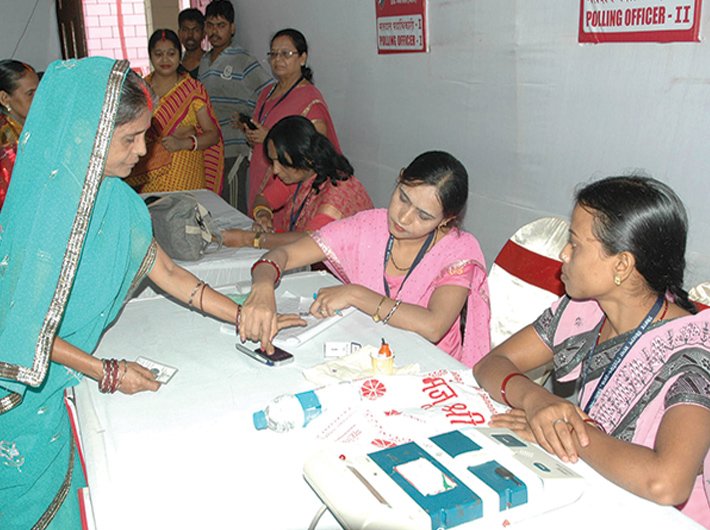In an interaction with women in Patna, Nitish promptly announced that given a chance to rule again, he would ban the sale of liquor.
Nitish Kumar cannot thank the women of Bihar enough for his decisive victory in assembly elections. He had worked for this day – by not only making promises but also delivering on them. The ubiquitous bicycle-riding girls on the way to schools who became the poster girls of Bihar’s development, sanitary napkins home-delivered to adolescent girls, and above all the job quota for women in police – all this during Nitish’s 10-year rule has changed life for women of Bihar.
In return, Nitish has not only earned the tag of the most women-friendly chief minister but also clinched a handsome victory against his formidable rival, BJP, and evened its equation with what could have been a difficult ally – RJD.
A look at the numbers of the recently concluded assembly elections is enough for sociologists to conclude that Nitish’s assiduous nurturing of a constituency – women – is a key factor behind his spectacular victory.
“Unlike in states like West Bengal (where widows faced discrimination), Uttar Pradesh or Madhya Pradesh, women in Bihar didn’t face oppression; they are fairly liberated, but lacked interest and a sense of participation in democracy due to the prevailing ground situation,” says Shaibal Gupta, founder of the Asian Development Research Institute, Patna and a leading Bihar expert.
He cites two revolutionary decisions by Nitish that had propelled women’s interests in democracy: 50 percent reservation for women in grassroots democratic institutions like panchayats and 35 percent job quota in police. “These changed the ground rules for women and under Nitish governance became a combination of being a provider and an enabler,” adds Gupta. By providing bicycles and sanitary napkins to girls, the government became a provider and by choosing to become the first state in India to implement 50 percent mandatory reservations of women in panchayat and civic bodies it became the enabler – to the empowerment of women, he explains.
Nitish’s decade-long rule saw a focused approach to women. He created institutional mechanisms for empowering women instead of merely indulging in populism. “From the word go, Nitish Kumar actually believed in politics of empowering women as a way to changing the society. He does not believe in mere lip service or symbolic gesture,” says Pratyush Nandan, chief of Chattra Janata Dal (United) (students’ wing) and a member of Nitish’s election team.
No wonder, women were a key element in his electioneering strategy as well. Nandan, who travelled with Nitish on the campaign trail, recounts his leader’s style of addressing women at the end of each rally. “Mothers and sisters, on the day of polling, make sure to come out of your homes in large numbers,” Nitish would say. “Just make sure the first thing you do on that day is go for voting. Cooking can wait. Also make sure you serve a tasty meal to the men folk only after they have voted; those who do not, serve them only one meal and make them fast to do penance.”
This light-hearted repartee to win votes did not go unheard.
About 60 percent of women voters cast their vote as against 54 percent men. “The women’s votes gave that extra push to our numbers and made the mahagathbandhan [JD(U), RJD and Congress] win,” says KC Tyagi, secretary general, JD(U). His party’s election promises listed in the manifesto include 35 percent job reservations for women across the government.
Has the Bihar election results finally thrown up the image of an assertive woman voter, whose political choices are not dictated by the males?
Has the Bihar model of electoral politics as espoused by Nitish Kumar given the ultimate success mantra – nurturing women as a constituency – to the predominantly male political class?
Of course, women-centric policies or pronouncements to get their votes are not new – J Jayalalitha-led AIADMK had announced a pre-election sops of gifting grinder mixies, washing machines, goats, saris, etc. costing around '7,000 crore, specifically targeting women voters in the last elections of 2011. This surely helped her win but did not lead to institutionalised changes that can really empower women.
Dr Sayeeda Hamid, former member of national commission for women as well as the planning commission, says that freebies do not serve the cause of women’s empowerment or development. “Leaders playing to the galleries to get women’s votes do not help the cause and will not be remembered for long,” she says.
However, as against this one-election harvest of women’s votes in Tamil Nadu, figures of Bihar elections unravel a fascinating story of women’s growing interest in the political process and also making independent choices while voting. This muted trend triggered in Bihar could change the paradigm of governance and politics in coming years.
Rahul Verma of the Lokniti-CSDS (Centre for the Study of Developing Societies), a policy think tank which monitors developments including elections in Bihar, narrates interesting instances on how women’s perception on leaders and politics is different from men’s. His conclusion is backed by the data of famed Lokniti-CSDS field surveys done from time to time.
For example, there was a latent anger and also confusion among women voters on their loyalty after Nitish’s party had joined hands with Lalu Prasad’s RJD. The latter didn’t enjoy a good image, particularly among the women, thanks to the memories of the of ‘jungle raj’, a euphemism for poor law and order situation, during its regime. The Nitish camp was also conscious and somewhat worried about this factor.
It just happened that Nitish was interacting with women in Patna during the election campaign when some of them complained of easy availability of alcohol and how it was destroying peace and economy of their homes. Nitish promptly announced that given a chance to rule again, he would ban the sale of liquor. The announcement turned out to be the game changer in a subtle way. At this stage the Lokniti-CSDS conducted a survey to gauge Nitish’s popularity. “We found that Nitish’s popularity among women had suddenly gone up after he promised prohibition,” says Verma. Analysts feel this single announcement had made many fence-sitter women voters decide in his favour and ultimately turn the tide against BJP and allies.
Verma says though the huge turnout of women voters was a clear indicator of their empowerment, it was not an isolated case. “In Bihar women’s participation in elections has been increasing in each election and that says a lot about changing ground realities,” he adds. During the 2000 assembly elections the gap between men’s and women’s voting was 16.3 percent which first narrowed down and with each passing election got reversed – women’s turnout surpassed men’s in the 2010 assembly and 2014 general elections. This trend has continued.
Nitish’s popularity among women has remained constant. In the run-up to the 2014 Lok Sabha elections, CSDS-Lokniti had asked voters to choose between Narendra Modi and Nitish as their favourite candidate as prime minister. It was the peak of the ‘Modi wave’, and voters were to indeed choose him over Nitish. However, the figures showed that the men and women had replied differently to this question: 59 percent of men favoured Modi as the PM candidate, as against 50 percent of women.
Again, the survey asked respondents if they believed Nitish could become the PM and whether he would make a good one, and he turned out to be more popular among women than men – about 17 percent of men and 24 percent of women gave him a thumbs-up for the job. In the same survey, 28 percent of men and 32 percent of women felt that he would be a good PM.
It is interesting to note that Nitish’s JD(U) did not do well in the 2014 elections, ending up at a poor third in terms of vote share. But this did not deprive him of the women’s support – as per the survey data, more women than men had voted for his party.
Hamid, who widely travelled across Bihar as member of the erstwhile planning commission, says women’s empowerment in the state had led to interventions in areas that men could never think of, for example, nutrition, basic education – particularly girls’– and hygiene. “When men get power to change things, they tend to pick up more flamboyant aspects of governance; women are good at seeing and addressing the basics,” she says.
However, Hamid is critical of Nitish for allowing panchayats to become a hub of nepotism and dynastic rule in the name of women’s empowerment. She claims to know a lot of women, who have become elected representatives only because of their families. “Doing window-dressing in the name of women empowerment would surely boomerang,” she warns. Also, she expects Nitish to focus on quality of governance at the grassroots in his current term. “He has to create an institutional mechanism to rein in women who tend to behave more like men in panchayats,” she says.
Women’s decisiveness and making independent choices in voting could be one of the reasons why most pollsters had mis-read the Nitish wave as a BJP wave. Since elections and related works are still seen as a macho subject and are covered – as reporters or response gatherers – by the males, it is possible that they failed to understand the non-conspicuous women’s response and therefore erred.
However, politically, despite his grandstanding and overwhelming support from women, Nitish has failed to break the stranglehold of caste in politics. Lokniti-CSDS found that his appeal among women voters failed to transcend the caste – everyone, including women, had voted along caste lines.
The JD(U) leadership is also aware of this pitfall which renders all revolutionary waves redundant. According to a senior JD(U) leader, who did not wish to be quoted, said,“ In Bihar the caste identity is very strong. When women vote for Nitish Kumar, they too vote along caste lines – this will not go, at least in my lifetime.”
aasha@governancenow.com
(The story appears in the December 16-31, 2015 issue)

